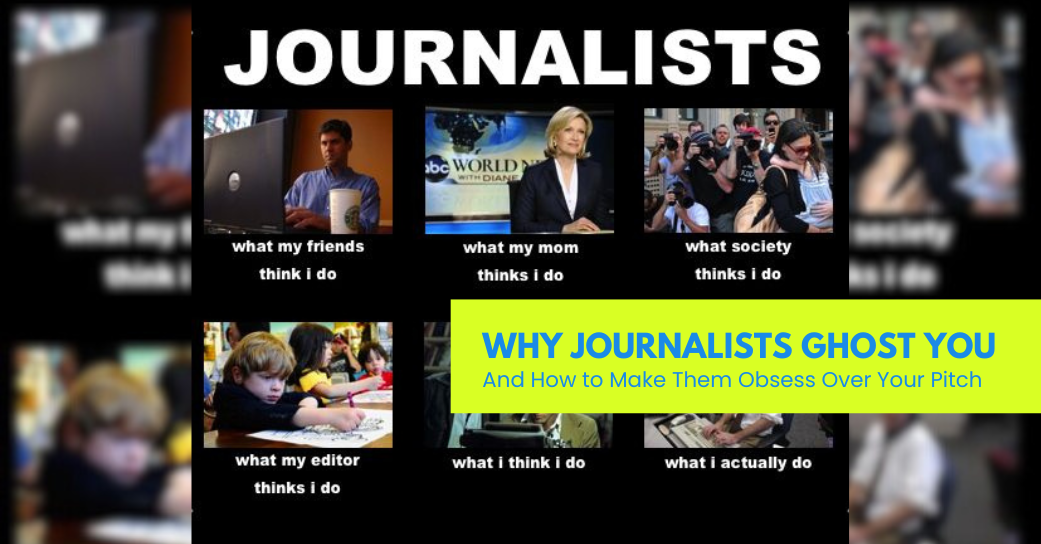
You’ve spent hours crafting the perfect pitch. The subject line is punchy, the story is solid, and you’ve triple-checked for typos. You hit send… then silence.
No reply. No follow-up. Not even a polite “not a fit.” Just pure, echoing nothingness.
If you’ve ever felt personally victimized by a journalist’s inbox, you’re not alone. The truth? Journalists aren’t ignoring you because they’re evil or allergic to your brand. They’re drowning.
According to a 2024 Muck Rack study, 46% of journalists receive six or more pitches every workday, and 49% seldom or never respond to them. That means you’re not just competing with other founders or agencies… you’re competing with chaos.
So, why exactly do journalists ghost you? And better yet, how do you become the pitch they can’t stop thinking about?
1. You’re Leading With Your Ego, Not Your Story
We get it… You’re proud of your product. You should be. But if your pitch reads like a sales brochure, it’s headed straight for the trash.
Journalists aren’t here to promote you; they’re here to tell stories that resonate with their readers. If your email starts with “Our revolutionary platform is changing the industry,” you’ve already lost them.
Fix it: Lead with a story, not a slogan. What sparked the idea? What problem does it actually solve?
People connect with humans, not hype.
Take a cue from startups that win coverage effortlessly; they talk about pain, perseverance, and personality. That’s what turns “a product” into “a piece worth publishing.”
2. Your Pitch Is All About You
Harsh truth: Journalists don’t care about your brand. They care about their readers.
If your pitch doesn’t immediately answer why this matters now or why their audience should care, you’ve given them zero reason to respond.
Fix it: Research the outlet. Reference a recent article the journalist wrote and connect your story to it.
Example: “You recently covered how small businesses are using AI to scale operations. Our founder built a tool that makes that process 5x faster.”
Relevance turns cold pitches into warm leads.
3. You’re Forgetting the “Why Now”
Timing is everything in PR. Even the best story can flop if it’s not relevant to what’s happening in the world.
Journalists live in a fast cycle of trends, data, and deadlines. If your pitch feels timeless, it also feels toothless.
Fix it: Tie your story to something bigger: a new regulation, a cultural shift, a recent headline. If it’s not newsworthy today, it’s not newsworthy at all.
4. You Sound Like Every Other PR Robot
If your pitch could have been written by ChatGPT in 30 seconds, congratulations! You’re in the recycle bin.
Journalists can smell generic copy from a mile away. They crave authenticity, humor, and a point of view.
Fix it:
- Write the way you’d actually talk: clear, direct, and conversational.
- Cut empty phrases like “innovative,” “disruptive,” and “leading.”
- Replace them with proof: real numbers, quotes, or results.
- Keep it short and easy to skim.
5. You’re Not Making Their Job Easier
Imagine you’re a journalist on deadline. You open a pitch with vague details, no quotes, no data, and no clear takeaway.
Are you going to dig for context? Nope. You’re hitting the archive and moving on.
Fix it: Include the pieces they’ll need to bring your story to life.
- A concise summary of the news
- One strong, pull-ready quote from your founder
- A link to visuals or press assets
- Key data points that add weight to the narrative
The faster they can turn your email into an article, the better your odds.
6. You’re Pitching the Wrong Person
Here’s a simple way to burn bridges fast: send your fintech pitch to a food writer.
It sounds ridiculous, but it happens constantly. According to PR News Online, three out of four journalists say most pitches they get are irrelevant to their beat.
Fix it: Before you hit send, read three of the journalist’s recent articles. Learn what they actually cover, not what you wish they did.
Personalization isn’t just about dropping their name in the first line; it’s about proving you know their lane.
7. You Quit After One Follow-Up
The first email might not get seen. The second one might land when they’re slammed. But a polite, well-timed follow-up can make all the difference.
Fix it: Wait a few days and follow up with something simple like: “Just checking if this might be a fit for an upcoming story. Happy to share more details if helpful.”
Professional persistence reads as confidence, not desperation.
8. You’re Focused on Attention Instead of Connection
The best PR doesn’t come from chasing coverage; it comes from building relationships.
When journalists know you send relevant, well-written, non-spammy stories, you become a trusted source. And trust is the ultimate PR currency.
Stop pitching like a robot and start connecting like a human. That’s how real media relationships begin, and how stories start to snowball.
How to Make Journalists Actually Care
To recap:
- Be relevant
- Be human
- Be helpful
- Be newsworthy
When you show that you understand what makes a story worth telling, journalists stop ghosting you and start keeping an eye out for your next pitch.
That’s exactly how we approach PR at Don’t Be A Little Pitch. We don’t chase clicks or count empty impressions. We craft stories that make people feel something… the kind that get shared, remembered, and ranked.
Own the Spotlight and Stop Getting Ghosted
If your inbox has turned into a PR graveyard, it’s time to change how you pitch.
At Don’t Be A Little Pitch, we help startups and emerging brands build credibility and momentum through story-driven PR, not outdated fluff.
We’ve seen what works, what flops, and what makes editors hit “reply.” And we’re here to help you stop begging for attention and start owning it.
👉 Visit dontbealittlepitch.com to see how we turn pitches into press and founders into headlines.
60-Day Guarantee
PR only works if it builds fast. If we don’t land you 2 major features and line up 3 more within 60 days, you’ll get a full refund - no questions asked.
Free Authority Score Checker
Check your online reputation and authority score for free and see how you stack up and get custom tips to improve instantly.









